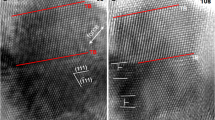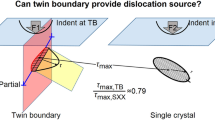Abstract
The deformation mechanisms of twin-structured metallic materials have attracted great interest. Though previous theoretical predictions have suggested that the repulsive force of the twin boundary (TB) can significantly affect the deformation of twin-structured metals, it remains unclear whether this prediction applies to experimental conditions. In this paper, the atomic-scaled deformation process of twin-structured Pt nanocrystals was in situ observed using our home-made device in a high-resolution transmission electron microscope. We have shown that the plastic deformation of the twin-structured Pt nanocrystals was governed by full dislocation generation as well as Lomer dislocation (LD) lock formation and destruction. After LD locks were destructed, these full dislocations tended to move towards the surface of the nanocrystals. The findings revealed that due to the ultra-high repulsive force of TB on dislocation, there was no dislocation-TB reaction during the deformation. These findings can enrich our understanding of the dislocation behaviors of twin-structured nanocrystals.
Similar content being viewed by others
References
Lu L, Chen X, Huang X, et al. Revealing the maximum strength in nanotwinned copper. Science, 2009, 323: 607–610
Wu X L, Zhu Y T, Wei Y G, et al. Strong strain hardening in nanocrystalline nickel. Phys Rev Lett, 2009, 103: 205504
Cao A J, Wei Y G, Mao S X. Deformation mechanisms of face-centered-cubic metal nanowires with twin boundaries. Appl Phys Lett, 2007, 90: 151909
Wang L, Lu Y, Kong D, et al. Dynamic and atomic-scale understanding of the twin thickness effect on dislocation nucleation and propagation activities by in situ bending of Ni nanowires. Acta Mater, 2015, 90: 194–203
Jang D, Li X, Gao H, et al. Deformation mechanisms in nanotwinned metal nanopillars. Nat Nanotech, 2012, 7: 594–601
Zhu T, Li J, Samanta A, et al. Interfacial plasticity governs strain rate sensitivity and ductility in nanostructured metals. Proc Natl Acad Sci USA, 2007, 104: 3031–3036
Lu L, Shen Y, Chen X, et al. Ultrahigh strength and high electrical conductivity in copper. Science, 2004, 304: 422–426
Zhu Y T, Liao X Z, Wu X L. Deformation twinning in nanocrystalline materials. Prog Mater Sci, 2012, 57: 1–62
Wang L, Liu P, Guan P, et al. In situ atomic-scale observation of continuous and reversible lattice deformation beyond the elastic limit. Nat Commun, 2013, 4: 2413
Liao X Z, Zhou F, Lavernia E J, et al. Deformation twins in nanocrystalline Al. Appl Phys Lett, 2003, 83: 5062–5064
Li X, Wei Y, Lu L, et al. Dislocation nucleation governed softening and maximum strength in nano-twinned metals. Nature, 2010, 464: 877–880
Ni S, Wang Y B, Liao X Z, et al. The effect of dislocation density on the interactions between dislocations and twin boundaries in nanocrystalline materials. Acta Mater, 2012, 60: 3181–3189
Zhu Y T, Wu X L, Liao X Z, et al. Dislocation-twin interactions in nanocrystalline fcc metals. Acta Mater, 2011, 59: 812–821
Yamakov V, Wolf D, Phillpot S R, et al. Dislocation-dislocation and dislocation-twin reactions in nanocrystalline Al by molecular dynamics simulation. Acta Mater, 2003, 51: 4135–4147
Jin Z H, Gumbsch P, Ma E, et al. The interaction mechanism of screw dislocations with coherent twin boundaries in different face-centred cubic metals. Scripta Mater, 2006, 54: 1163–1168
Jin Z H, Gumbsch P, Albe K, et al. Interactions between non-screw lattice dislocations and coherent twin boundaries in face-centered cubic metals. Acta Mater, 2008, 56: 1126–1135
Wu Z X, Zhang Y W, Srolovitz D J. Dislocation-twin interaction mechanisms for ultrahigh strength and ductility in nanotwinned metals. Acta Mater, 2009, 57: 4508–4518
Jin J, Shevlin S A, Guo Z X. Multiscale simulation of onset plasticity during nanoindentation of Al (001) surface. Acta Mater, 2008, 56: 4358–4368
Shabib I, Miller R E. Deformation characteristics and stress-strain response of nanotwinned copper via molecular dynamics simulation. Acta Mater, 2009, 57: 4364–4373
Frøseth A G, Derlet P M, Van Swygenhoven H. Grown-in twin boundaries affecting deformation mechanisms in nc-metals. Appl Phys Lett, 2004, 85: 5863–5865
Afanasyev K A, Sansoz F. Strengthening in gold nanopillars with nanoscale twins. Nano Lett, 2007, 7: 2056–2062
Wang Y B, Sui M L. Atomic-scale in situ observation of lattice dislocations passing through twin boundaries. Appl Phys Lett, 2009, 94: 021909
Wang Y B, Wu B, Sui M L. Dynamical dislocation emission processes from twin boundaries. Appl Phys Lett, 2008, 93: 041906
Sennour M, Lartigue-Korinek S, Champion Y, et al. Local strain analysis in twin boundaries in ultrafine grained copper. J Mater Sci, 2008, 43: 3806–3811
Wu X L, Narayan J, Zhu Y T. Deformation twin formed by self-thickening, cross-slip mechanism in nanocrystalline Ni. Appl Phys Lett, 2008, 93: 031910
Wu X L, Zhu Y T. Inverse grain-size effect on twinning in nanocrystalline Ni. Phys Rev Lett, 2008, 101: 025503
Li N, Wang J, Misra A, et al. Twinning dislocation multiplication at a coherent twin boundary. Acta Mater, 2011, 59: 5989–5996
Wang J, Huang H. Novel deformation mechanism of twinned nanowires. Appl Phys Lett, 2006, 88: 203112
Deng C, Sansoz F. Repulsive force of twin boundary on curved dislocations and its role on the yielding of twinned nanowires. Scripta Mater, 2010, 63: 50–53
Chen Z, Jin Z, Gao H. Repulsive force between screw dislocation and coherent twin boundary in aluminum and copper. Phys Rev B, 2007, 75: 212104
Wang L, Teng J, Liu P, et al. Grain rotation mediated by grain boundary dislocations in nanocrystalline platinum. Nat Commun, 2014, 5: 4402
Zhang Y, Han X, Zheng K, et al. Direct observation of super-plasticity of beta-SiC nanowires at low temperature. Adv Funct Mater, 2007, 17: 3435–3440
Kong D, Xin T, Sun S, et al. Surface energy driven liquid-drop-like pseudoelastic behaviors and in situ atomistic mechanisms of small-sized face-centered-cubic metals. Nano Lett, 2018, 19: 292–298
Sun S, Kong D, Li D, et al. Atomistic mechanism of stress-induced combined slip and diffusion in sub-5 nanometer-sized Ag nanowires. ACS Nano, 2019, 13: 8708–8716
Wang L, Teng J, Sha X, et al. Plastic deformation through dislocation saturation in ultrasmall Pt nanocrystals and its in situ atomistic mechanisms. Nano Lett, 2017, 17: 4733–4739
Gururajan M P. Theory of dislocations, 3rd edition. Contemporary Phys, 2018, 59: 312–313
Wang L, Guan P, Teng J, et al. New twinning route in face-centered cubic nanocrystalline metals. Nat Commun, 2017, 8: 2142
Jin Z H, Dunham S T, Gleiter H, et al. A universal scaling of planar fault energy barriers in face-centered cubic metals. Scripta Mater, 2011, 64: 605–608
Bernstein N, Tadmor E B. Tight-binding calculations of stacking energies and twinnability in fcc metals. Phys Rev B, 2004, 69: 094116
Wang L, Kong D, Zhang Y, et al. Mechanically driven grain boundary formation in nickel nanowires. ACS Nano, 2017, 11: 12500–12508
Hao L, Liu Q, Fang Y, et al. Mechanical behavior of metallic nanowires with twin boundaries parallel to loading axis. Comput Mater Sci, 2019, 169: 109087
Wang L, Zhang Z, Ma E, et al. Transmission electron microscopy observations of dislocation annihilation and storage in nanograins. Appl Phys Lett, 2011, 98: 051905
Author information
Authors and Affiliations
Corresponding authors
Additional information
This work was supported by the National Key R&D Program of China (Grant No. 2017YFB0305501), the Beijing Outstanding Young Scientist Projects (Grant No. BJJWZYJH01201910005018), the National Natural Science Foundation of China (Grant Nos. 11722429, 51771104, 91860202), “111” Project (Grant No. DB18015), the Beijing Natural Science Foundation (Grant No. Z180014) and the Fok Ying-Tong Education Foundation of China (Grant No. 151006).
Rights and permissions
About this article
Cite this article
Guo, Y., Sun, T., Fu, L. et al. In situ atomic-scale observation of dislocation behaviors in twin-structured Pt nanocrystals. Sci. China Technol. Sci. 64, 599–604 (2021). https://doi.org/10.1007/s11431-020-1542-7
Received:
Accepted:
Published:
Issue Date:
DOI: https://doi.org/10.1007/s11431-020-1542-7




